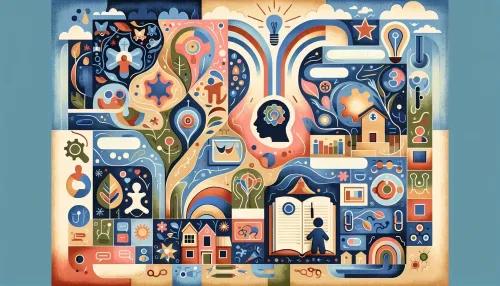
Uniting for Understanding: The Global Educational Initiative Transforming Autism Awareness

The conversation around autism is shifting, evolving from awareness to acceptance and now to understanding. As we navigate the complex spectrum of neurodiversity, educators worldwide are harnessing a new sense of commitment toward inclusive education. Exploring how the global educational initiative is not just illuminating the challenges faced by autistic children but also celebrating their unique strengths and perspectives.
Building a Worldwide Network: International Schools Join Forces for Autism
Gone are the days when autism education was limited to a select few institutions or countries. In an inspiring display of solidarity, international schools are linking arms across oceans and time zones to create a unified network supporting autistic learners. This growing coalition shares resources, strategies, and expertise, ensuring every child regardless of nationality has access to the most progressive and effective learning environments.
Making strides in social connectivity and digital collaboration tools has empowered this network. It's united by a common goal: transforming how society perceives neurodivergent individuals and nurturing their talents in a world that often leans toward conformity.
Collaborative Curriculum Design: Crafting Lessons that Embrace Neurodiversity
At the core of this international initiative is the idea that traditional curricula must evolve. Classes need to embrace the full spectrum of brain differences by integrating subjects like social communication, sensory processing, and adaptive life skills alongside conventional academic topics.
This holistic approach goes beyond merely including autistic children in standard lessons; it's about redesigning those lessons from the ground up. With inputs from a plethora of cultures and teaching philosophies, educators are crafting curricula that acknowledge neurodiversity as a natural and valuable form of human variability.
Sharing Success Stories: How Global Partnerships Enhance Learning for Autistic Kids
One hallmark of the HorizonsMind Blog commitment is to highlight success stories real narratives revealing how global partnerships can have a transformative impact on learning outcomes for autistic children. Whether it's a technological breakthrough used in South American classrooms or a Scandinavian social integration technique, each story underscores one message: increased connection leads to better understanding and more tailored education for autistic learners.
These narratives not only inspire but also serve as blueprints for replication, helping other schools and communities adapt proven strategies to their specific contexts, driving us towards a universally empathetic approach to education.
Synergy in the Classroom: Teachers and Therapists Working Together
The educational landscape for autistic children now emphasizes interdisciplinary teamwork where teachers and therapists coalesce their skills. The synergy created within the classroom walls fosters an environment where learning goes hand-in-hand with therapeutic support a setting where speech therapists might work with language arts teachers or occupational therapists partner with physical education instructors.
This collaboration creates an ecosystem that promotes consistency in learning strategies and reinforcement of techniques aiding in better generalization of skills among students.
Inclusion Infusion: Adapting Educational Materials for Diverse Learners
Adapting education isn't just about curriculum overhaul it also includes the creation and refinement of materials that reflect an inclusion infusion ethos. Gone are one-size-fits-all textbooks and worksheets replaced by adaptive technologies and customizable content that caters to the fluid learning styles of autistic students.
In response to this need, creators are designing sensory-friendly learning aids and using storytelling methods that resonate across neurotypes, bridging gaps between traditional learners and their neurodiverse peers in meaningful ways.
Cross-Cultural Exchange: Leveraging Global Perspectives to Support Autistic Students
Cross-cultural exchange is vital in shaping globally responsive autism education the idea that different cultures can offer unique approaches to support neurodiverse learners. These exchanges shine a light on innovative practices such as mindfulness-based stress reduction from Asia or familial involvement techniques heralded in Latin cultures.
In turn, these diverse approaches not only enrich educational practices but also help foster acceptance in broader societal contexts, showing that different cultures have different strengths when it comes to supporting autistic children.
Technology Tie-ups: Innovating Digital Tools for Autism Education
Modern technology has revolutionized various aspects of our lives, and education for autistic children is no exception. Strides in EdTech have given rise to cutting-edge digital tools designed specifically for autism education apps that facilitate non-verbal communication, virtual reality experiences reducing anxiety around new environments, or AI-driven platforms offering personalized learning journeys.
These technology tie-ups open unprecedented avenues for engagement and interactivity essential for students on the spectrum who might struggle with traditional pedagogical approaches.
Research Without Borders: Joint Studies Improving Outcomes for the Autistic Community
The scholarly community plays an integral role in advancing global knowledge about autism. Through international research initiatives studies without borders scientists uncover new insights into best educational practices catering to autism spectrum conditions.
As these joint efforts yield findings about brain plasticity or sensory integration effectiveness, they empower educators to fine-tune teaching methods towards what science is increasingly understating as best serving our neurodiverse students' needs.
A Tapestry of Talents: Uniting Educators and Specialists in Autism Advocacy
To conclude this exploration on HorizonsMind Blog, we recognize the tapestry of talents among educators, specialists, parents, and advocates who tirelessly work towards inclusivity. As this collective body grows stronger and louder in its advocacy for autism understanding within education systems worldwide, we celebrate each thread of effort woven into this significant movement.


